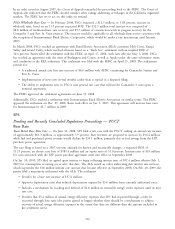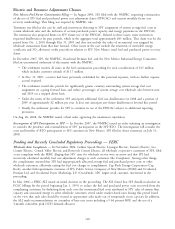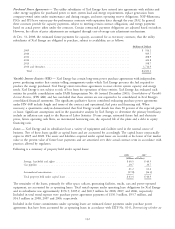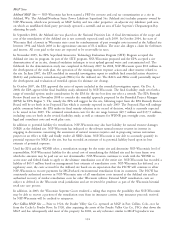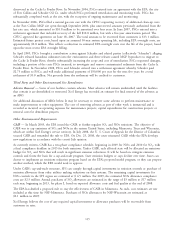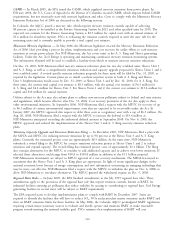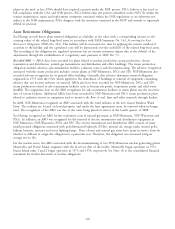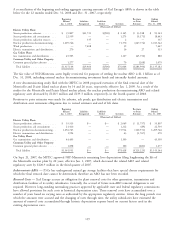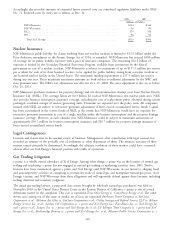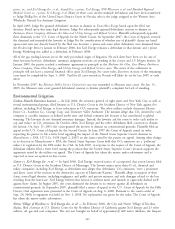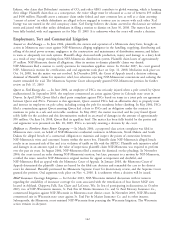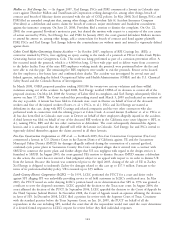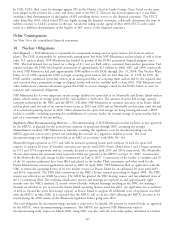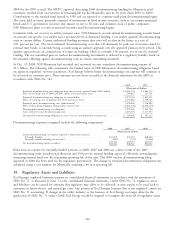Xcel Energy 2008 Annual Report Download - page 146
Download and view the complete annual report
Please find page 146 of the 2008 Xcel Energy annual report below. You can navigate through the pages in the report by either clicking on the pages listed below, or by using the keyword search tool below to find specific information within the annual report.CAMR — In March 2005, the EPA issued the CAMR, which regulated mercury emissions from power plants. In
February 2008, the U.S. Court of Appeals for the District of Columbia vacated CAMR, which impacts federal CAMR
requirements, but not necessarily state-only mercury legislation and rules. Costs to comply with the Minnesota Mercury
Emissions Reduction Act of 2006 are discussed in the following sections.
In Colorado, the AQCC passed a mercury rule, which requires mercury emission controls capable of achieving
80 percent capture to be installed at the Pawnee Generating Station by 2012 and other specified units by 2014. The
expected cost estimate for the Pawnee Generating Station is $2.3 million for capital costs with an annual estimate of
$1.4 million for absorbent expense. PSCo is evaluating the emission controls required to meet the state rule for the
remaining units and is currently unable to provide a total capital cost estimate.
Minnesota Mercury Legislation — In May 2006, the Minnesota legislature enacted the Mercury Emissions Reduction
Act of 2006 (Act) providing a process for plans, implementation and cost recovery for utility efforts to curb mercury
emissions at certain power plants. For NSP-Minnesota, the Act covers units at the A. S. King and Sherco generating
facilities. Under the Act, Xcel Energy is operating and maintaining continuous mercury emission monitoring systems.
The information obtained will be used to establish a baseline from which to measure mercury emission reductions.
On Dec. 21, 2007, NSP-Minnesota filed mercury emission reduction plans for two dry scrubbed units, Sherco Unit 3
and A. S. King, as well as a comprehensive emissions reduction and capacity upgrade proposal for Sherco Units 1 and 2
(wet scrubbed units). A revised specific mercury reduction proposals for these units will be filed by Dec. 31, 2009, as
required by the legislation. Current plans are to install a sorbent injection system at both A. S. King and Sherco
Unit 3. Implementation would occur by Dec. 31, 2009, at Sherco Unit 3 and by Dec. 31, 2010, for A. S. King. For
these units, the current total capital cost estimate is $8.5 million, with the annual cost estimate of $4.3 million for
A. S. King and $4.2 million for Sherco Unit 3. For Sherco Units 1 and 2, the current cost estimate is $13.6 million for
capital and $10 million for annual expenses.
Utilities subject to the Act may also submit plans to address non-mercury pollutants subject to federal and state statutes
and regulations, which became effective after Dec. 31, 2004. Cost recovery provisions of the Act also apply to these
other environmental initiatives. In September 2006, NSP-Minnesota filed a request with the MPUC for recovery of up
to $6.3 million of certain environmental improvement costs that are expected to be recoverable under the Act. In
January 2007, the MPUC approved this request to defer these costs as a regulatory asset with a cap of $6.3 million. On
Aug. 26, 2008, NSP-Minnesota filed a request with the MPUC to increase the deferral to $19.4 million as
NSP-Minnesota anticipated exceeding the authorized deferral amount in September 2008. On Nov. 6, 2008, the
MPUC approved and ordered the implementation of the Sherco Unit 3 and A. S. King mercury emission reduction
plans.
Voluntary Capacity Upgrade and Emissions Reduction Filing — In December 2007, NSP-Minnesota filed a plan with
the MPCA and MPUC for reducing mercury emissions by up to 90 percent at the Sherco Unit 3 and A. S. King
plants. Currently, the estimated project costs are approximately $8.5 million. At the same time, NSP-Minnesota
submitted a revised filing to the MPUC for a major emissions reduction project at Sherco Units 1 and 2 to reduce
emissions and expand capacity. The revised filing has estimated project costs of approximately $1.1 billion. The filing
also contains alternatives for the MPUC to consider to add additional capacity and to achieve even lower emissions. If
selected, these alternatives could range from $90.8 to $330.8 million in addition to the $1.1 billion proposal.
NSP-Minnesota’s investments are subject to MPUC approval of a cost recovery mechanism. The MPCA has issued its
assessment that the Sherco Unit 3 and A. S. King plans are appropriate. In light of recent significant changes in the
national economy, lower forecast of energy consumption, and new information concerning an emerging technology that
may be more cost effective, NSP-Minnesota filed a request with the MPUC to withdraw the plan on Nov. 6, 2008, to
allow NSP-Minnesota to reevaluate alternatives. The MPUC granted the withdrawal request on Dec. 9, 2008.
Regional Haze Rules — In June 2005, the EPA finalized amendments to the July 1999 regional haze rules. These
amendments apply to the provisions of the regional haze rule that require emission controls, known as BART, for
industrial facilities emitting air pollutants that reduce visibility by causing or contributing to regional haze. Xcel Energy
generating facilities in several states will be subject to BART requirements.
The EPA required states to develop implementation plans to comply with BART by December 2007. States are
required to identify the facilities that will have to reduce SO2, NOx and particulate matter emissions under BART and
then set BART emissions limits for those facilities. In May 2006, the Colorado AQCC promulgated BART regulations
requiring certain major stationary sources to evaluate and install, operate and maintain BART to make reasonable
progress toward meeting the national visibility goal. PSCo estimates that implementation of BART will cost
136


